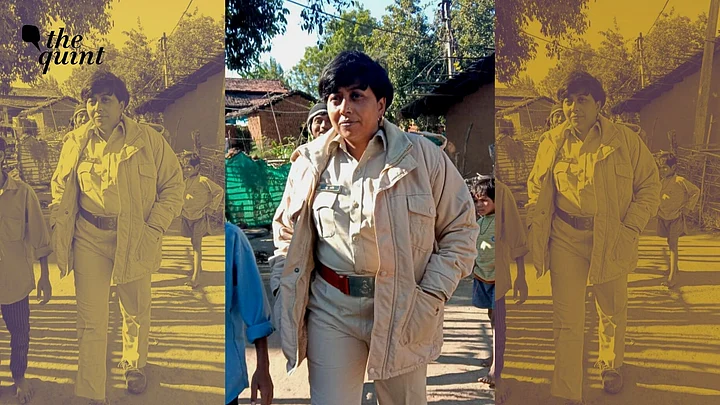"Life in and around the forest is tough. And, on most days, the challenge is not only about preserving the heritage and wildlife, but also about securing the interests of human groups and communities dependent on the forest," says Shashi Ahirwar, a 32-year-old forester posted in Bamnai village near the Ratapani Tiger Reserve in Madhya Pradesh.
Ahirwar is just one of the many other extraordinary foresters, forest officers, guards, rangers, and watchers who put their lives on the line every day for 'Project Tiger' – a government initiative launched in 1973 and aimed at saving the national animal of India from going extinct.
Ahirwar had also featured in Amit Masurkar's film Sherni which explores the themes of wildlife conservation and the man-animal conflict.
On the occasion of the International Tiger Day, Shashi Ahirwar spoke to The Quint about the struggles of being a female forester, what a day in her life looks like, and her mission to save the tiger.
A Day in The Life Of a Forest Officer
The forest was passed down to Ahirwar as a legacy by her father, she says. "I started my training under my father, Bijay Prakash, at the age of 23. My father was a deputy forest ranger. It's something that runs in the family."
Ahirwar, who hails from Rewa village in Madhya Pradesh, underwent a year-long training in Barkheda village near Indore in her home state. She was then posted at Karmai village before she took over as the forester in Bamnai.
Having always been an athletic person, Ahirwar was recognised multiple times by the forest department during her early years of training.
However, she feels that nothing can prepare a person for the challenges they face in the forest.
"The forest presents to you, a different challenge every day. Sometimes it concerns your own survival and on other days it's about the survival of other animals and humans who depend on the wild."Shashi Ahirwar, Forest Officer
Ahirwar, who lives with her mother, has to report to work at 9 am. Days when she and her team visit the field, are particularly hectic, she says. Work on field involves tracking the movement of wild animals, ensuring that the water reservoirs across the forest are well-equipped, and the cameras installed at multiple locations are functional.
For Ahirwar, some days are less taxing as compared to others. These are the days when there is no field visit – and her team mostly focuses on clearing the paperwork at their local office.
"But even paperwork can be very puzzling sometimes. Because it doesn't just involve filing records. It also involves engaging with multiple stakeholders, including local politicians and other bureaucrats, to address their grievances and ensure smooth functioning of our own department," Ahirwar says.
And what does she do when not at work? Well, it involves spending time with her mother and being a mother to her plants.
A Woman in The Forest
Despite women being an integral part of the forest ecosystem, Ahirwar feels that they are presented with a very varied set of challenges on a daily basis.
Sharing an anecdote from a field visit, she emphasises that in the face of adversities, she has on many occasions, found support in other women, mostly strangers, who belong to communities living along the forest. Hence, she herself makes it a point to uphold their interests while working towards conservation.
"During my first posting, I had to go on an assignment at midnight. It involved arresting a group of people on charges of hunting and poaching. The entire operation ended at 3 am and we were on the other end of the forest at that time. When my staff asked our senior officer about arrangements for me to stay the night, we received no help. It was at that point that some local women helped me and my staff."
'It's Man and Wild, not Man Vs Wild'
Speaking about the man-animal conflict, Ahirwar feels that as a society we need to drop the approach of 'man vs wild' and start thinking about co-habitation more seriously.
"Man and wild will have to learn to live together," she says.
When Ahirwar first came to Bamnai, she saw that several tribal women, belonging to the Barela community, were directly dependent on the forest to make a living. They travelled at least 14 km every day into the forest and back to collect woods for sale.
"This exercise of wood collection was not just tiring, but it also threatened the wildlife in the forest. Sometimes even women themselves would become targets of attacks by wild animals."Shashi Ahirwar, Forest Officer
Ahirwar's department helped women in the village hone their paper mache skills and later helped them sell products they made. With time, the dependence of local families on the forest reduced. "As of today, no woman from that village has to go to the forest to collect firewood. I am proud of having helmed a project like this."
On International Tiger Day, Shashi Ahirwar has a message for the rest of us.
She says that if there is a forest, there is a tiger, and if there is a tiger, there is a forest.
"The need of the hour is to strike a balance between man and the wild and that can only happen with popular public participation and support in wildlife conservation."
(The article has been reposted from The Quint's archives to mark International Tiger Day. It was originally published in 2021.)
(At The Quint, we question everything. Play an active role in shaping our journalism by becoming a member today.)
